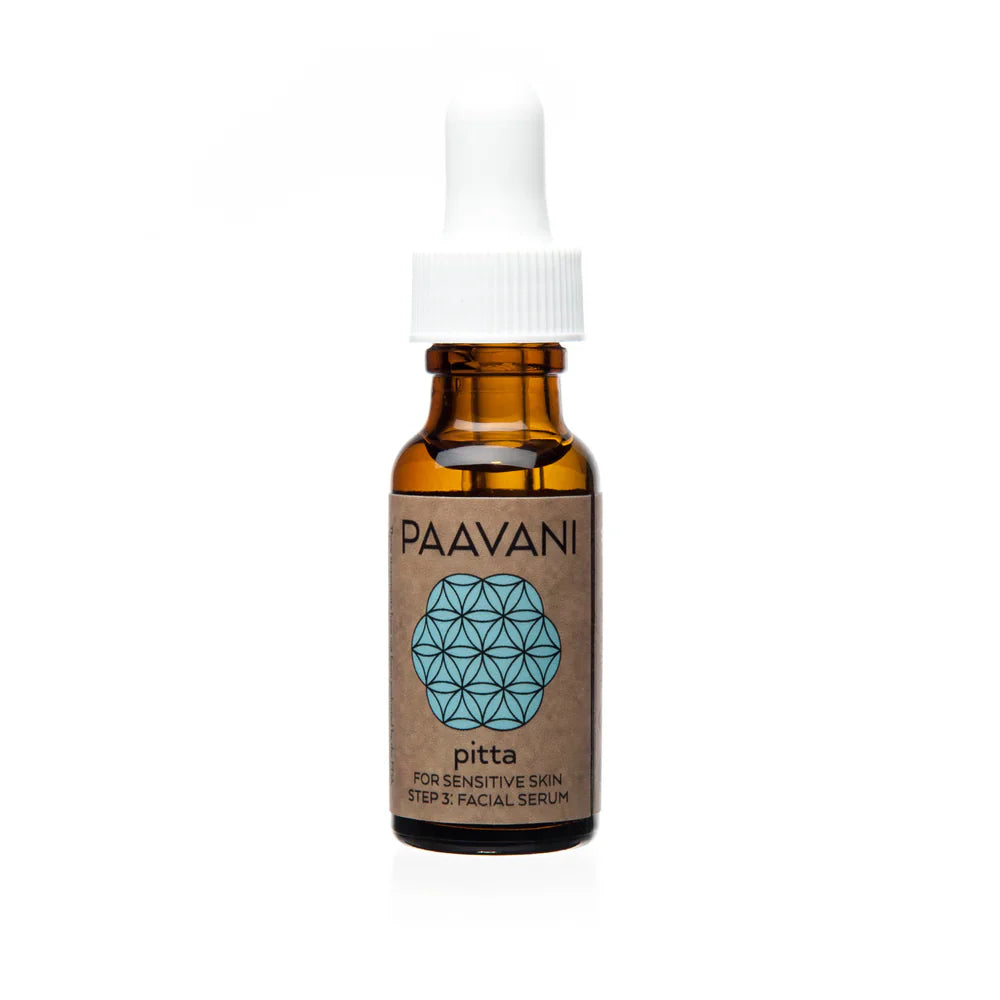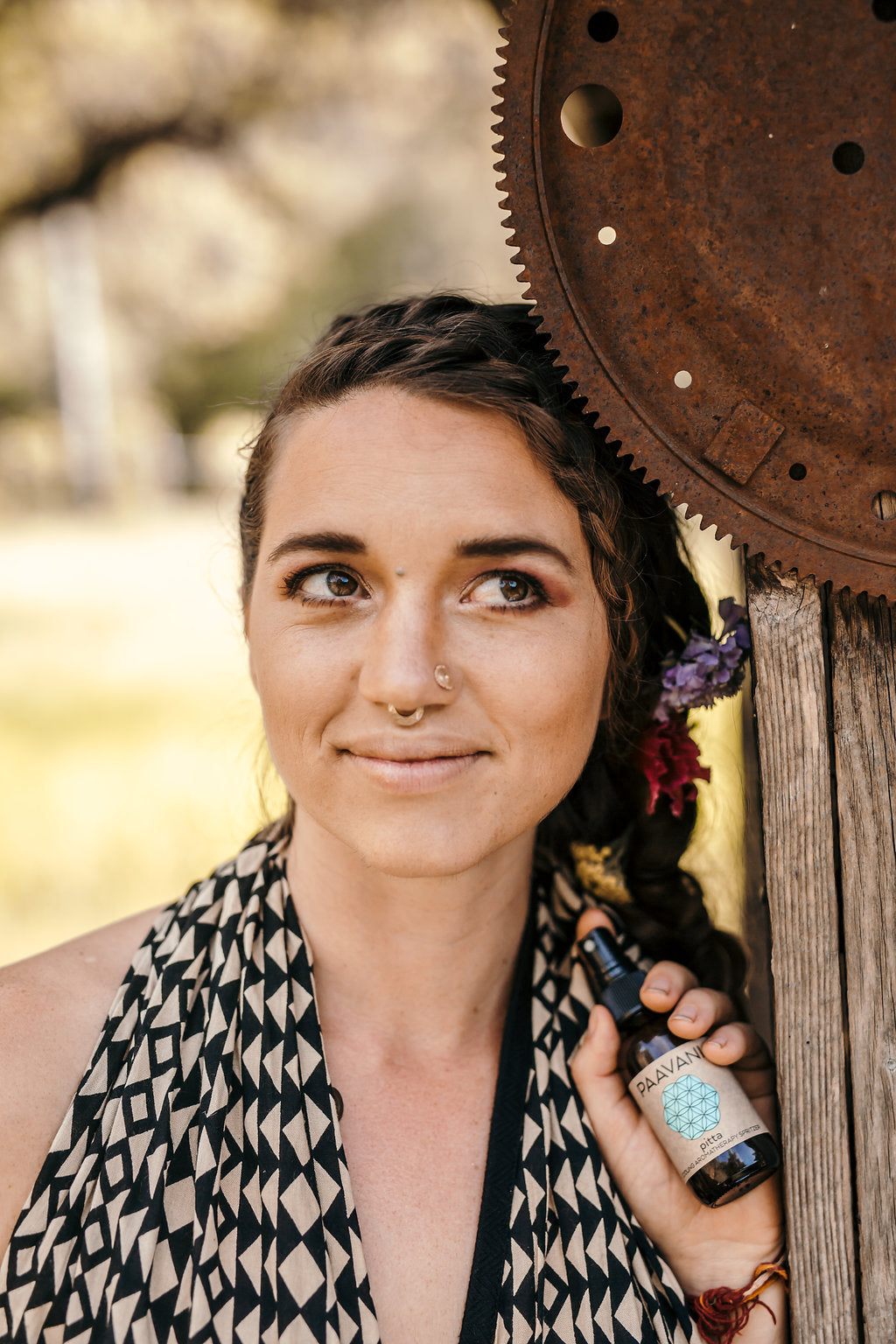
PAAVANI pitta facial serum: Ayurvedic skincare for balance
Product Spotlight: PAAVANI pitta facial serum & how it works
“But why would I want to put oil on my face? Won’t it make my face oilier & my breakouts worse?” We hear this question often at PAAVANI. The truth is, not all oils are created equal. Using the right oil for your dosha can transform your complexion. Our pitta facial serum was created for those with sensitive, oily, or blemish-prone skin who need balance rather than stripping.
Ayurveda teaches that beauty begins with harmony. The pitta facial serum embodies this ancient wisdom by cooling, calming & restoring equilibrium to pitta-type skin. When used consistently, this Ayurvedic serum helps clear blemishes, regulate oil, and reveal a radiant, even complexion. Let’s explore how the pitta facial serum works — ingredient by ingredient — to bring balance back to your skin.
Understanding non-comedogenic oils
The foundation of the pitta facial serum lies in non-comedogenic oils, which means they won’t clog pores. A comedo, or pimple, forms when excess sebum mixes with dead skin cells, blocking follicles and creating an environment where bacteria thrive. The result? Breakouts, inflammation & irritation — all hallmarks of pitta imbalance.
The pitta facial serum counteracts this process by providing lightweight hydration while supporting your skin’s natural barrier. Each oil in this serum is rich in linoleic acid, a fatty acid that helps thin sticky sebum and prevent pore blockages. By choosing the pitta facial serum, you’re helping your skin regulate oil naturally, rather than forcing it into imbalance through harsh products.
Key ingredients in the PAAVANI pitta facial serum
Every ingredient in the pitta facial serum was carefully chosen to serve a specific Ayurvedic purpose — cooling, balancing, and harmonizing the pitta dosha.
Hemp oil
Hemp oil has a comedogenic rating of 0, meaning it will not clog pores. Containing over 60% linoleic acid, it deeply hydrates while keeping sebum production in check. In the pitta facial serum, hemp oil provides the perfect foundation for sensitive or oily skin that needs moisture without heaviness.
Black cumin seed oil
This ancient oil, rich in zinc and over 100 beneficial compounds, soothes irritation while purifying skin. Its anti-inflammatory and antibacterial nature make it a vital component of the pitta facial serum for reducing acne and redness.
Pumpkin seed oil
Packed with omega-3 fatty acids, vitamins A & E, and antioxidants, pumpkin seed oil rejuvenates the skin’s natural glow. Within the pitta facial serum, it helps fade blemish scars, reduce inflammation, and improve overall skin tone.
Rose-infused safflower oil
To enhance the pitta facial serum’s cooling effect, we infuse dried rose petals into safflower oil for 72 hours. This creates a heart-opening, soothing oil that reduces heat and balances excessive pitta energy, leaving your skin feeling refreshed & nourished.
Castor oil
Castor oil detoxifies & softens, gently drawing out impurities while reducing oil buildup. The pitta facial serum harnesses this oil’s antimicrobial benefits to prevent blemishes and calm sensitive skin.
Tamanu oil
Tamanu oil supports cell regeneration, helping to heal sun exposure and reduce signs of aging. Its cicatrization properties encourage new tissue growth, making the pitta facial serum excellent for restoring elasticity and diminishing fine lines.
Tea tree essential oil
Tea tree oil purifies and balances, targeting the root of blemishes. It’s a natural antibacterial powerhouse that helps the pitta facial serum clear congested pores and maintain harmony between sebum & hydration.
Lavender essential oil
Lavender calms both the skin and the mind. Its soothing aroma and high linalol content make the pitta facial serum gentle enough for daily use, supporting emotional balance alongside skin wellness.
Geranium essential oil
Geranium is a harmonizer — it balances sebum, tones the skin, and encourages healing. In the pitta facial serum, it enhances suppleness while reducing redness and irritation.
Sandalwood essential oil
Used for thousands of years in Ayurvedic skincare, sandalwood cools pitta heat and restores clarity. Within the pitta facial serum, it soothes inflammation, minimizes breakouts, and promotes a natural, soft glow.
Frankincense essential oil
Frankincense promotes cell renewal and resilience. Its antiseptic properties make the pitta facial serum deeply restorative, supporting skin tone and elasticity while calming irritation.
The Ayurvedic wisdom behind facial oils
Ayurveda views skincare as self-care — an act of ritual. The pitta facial serum embodies this philosophy, offering a way to reconnect with nature’s balance. When used regularly, the pitta facial serum supports not just your skin, but your inner calm.
By choosing oils aligned with your dosha, you can restore your skin’s natural brilliance. The pitta facial serum is especially beneficial for those who experience redness, irritation, or inflammation, as it soothes while hydrating.
At PAAVANI, we formulate serums for every skin type:
vata – dry skin
pitta – sensitive skin
kapha – oily skin
tridoshic – balanced skin
clarify – acne-prone skin
Each blend, including the pitta facial serum, reflects our devotion to traditional Ayurvedic skincare & modern herbal science.
Reclaiming beauty rituals from the earth
Our mission is to reconnect beauty with the wisdom of the earth. The pitta facial serum uses pure botanicals — herbs, roots, seeds & flowers — to balance the body’s natural rhythms.
When you replace chemical-based moisturizers with an organic, Ayurvedic serum like the pitta facial serum, your skin begins to glow with vitality & authenticity. This serum nourishes deeply, helping you embody timeless beauty from the inside out.
Experience radiant, balanced skin.
👉 Shop the PAAVANI pitta facial serum today & reconnect with your skin’s natural harmony.





Leave a comment
This site is protected by hCaptcha and the hCaptcha Privacy Policy and Terms of Service apply.